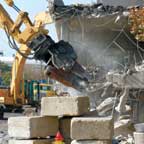
When construction or demolition activity is under way, people in adjacent buildings often feel vibrations and become concerned about property damage. It may be an annoying flutter that causes air-conditioner ducts to rattle or an uncomfortable shimmy that makes people worry about safety. In the majority of cases, the fix is relatively straightforward: find the source and correct it or strengthen the structure to eliminate it.
Vibration-sensitive equipment such as Magnetic Resonance Imaging (MRI) systems, Computed Tomography (CT) scanners, and surgical microscopes are capable of remarkable resolution and image quality but can be sensitive to vibration levels that are far below the threshold of human perception. These vibrations are much harder to fix. The following examples illustrate vibration problems and the resulting solutions.
Public Safety
When construction on a site in Chicago required the installation of steel sheet piles by vibrator, the local gas utility became concerned about the safety of 80- to 100-year-old cast-iron gas mains around the site. No reliable guidelines had been established for acceptable vibration levels on such elderly pipeline, so a vibration and displacement monitoring program was established to track both the vibration levels and the stresses they caused on the gas mains. Daily monitoring enabled the contractor to minimize vibrations and keep pipeline displacement within a range that was acceptable to the utility company.
Worrisome Building Vibrations
Occupants of a multi-story office building in a Chicago suburb complained of uncomfortable vibrations caused by people walking by. Measurements indicated that differences in wall and filing cabinet locations on various floors had a significant effect on the sensitivity of the floor to such activities as people walking by, mechanical equipment, and doors closing. To solve the problem, floor-to-floor connections were made using a combination of columns and partition walls. The vibrations were reduced to a barely noticeable level, even when a 230-pound man stomped heavily through the room.
Surgical Microscope
Surgeons at a Chicago hospital complained of blurred images when using a surgical microscope in a new operating room. Vibration measurements showed the floor was vibrating at its natural frequency, but the vibrations were cyclical—rising and falling in amplitude. Additional vibration measurements recorded throughout the hospital traced the cause to air-conditioning equipment in an adjacent building. The equipment was serviced by a HVAC contractor, and vibration isolation springs were installed at critical mounting points. The microscope image quality improved to an acceptable level.
Taking Action
The significance of a vibration depends on its effect. Blurred microscope or MRI images can be just as unacceptable and costly as structural damage. Whenever a facility owner or manager is concerned about possible vibration issues, the first step is to engage an experienced consultant to quantify the vibration, confirm the source, and assess the potential for damage. IBI

